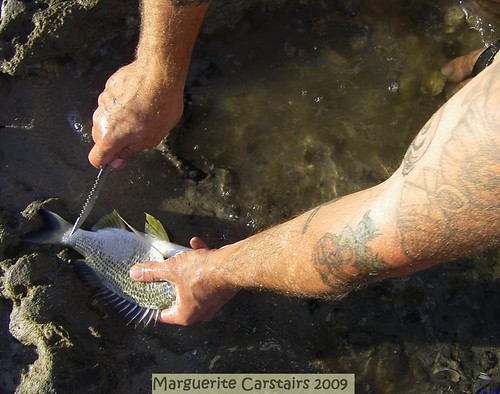Fresh bream caught at Burrum Heads
The rocks are the perfect place to clean the fish
The rock pool provides the water and a sharp Fish cleaning knife is all that is required.
The fish is scaled, the guts are removed, and it is ready for cooking
Bream usually inhabit rough, snaggy areas, 2 m to 6 m in depth. They feed together in schools, usually around areas which give them some protection, such as sunken logs, oyster bases, eroded banks or the base of rock walls.
During the winter months they congregate in the deep fast running waters, somewhere near surf bars where rivers and estuaries empty into the open sea, and bite best during the night and at dawn.
Favoured nights in the winter months would be the big tide nights which correspond with the periods a few nights before and up to the full moon and new moon.
Round running sinkers are used to give maximum bait movement, sizes from No.00 ball to No.3 ball, dependent on the tidal run. The best rig has the sinker directly above the hook, with a small No.10 free turning swivel about 1 metre above the sinker. The sinker on hook gives you direct contact with your ball whether fishing into or against the tide and is easier to remove when snagged. It does not lessen bites when bream fishing, and the bites are better registered to the angler. To fish the right area, the angler must be prepared to lose rigs through snagging.
Bream do not like clear water, and it is rare to be able to catch any fish which is visible to you in the water. Therefore off shore, windy conditions do not produce good fishing, but the fish reappear when a sea breeze brings turbulence and cloudy water. When fishing piers or jetties, do not neglect to cast under the structure. The bream feed and shelter around the piles, often right under where you are standing. The wind and lean method is most important when bream fishing. Never attempt to set the hook by striking with the rod, or every fish swimming across or towards you will be lost.
The bream has been given credit for being a wily or clever fish, yet in reality is one of the easiest to catch. he only time it indulges in picking at food, is when the angler is not presenting the bait properly. Fish correctly and its biting method rarely varies, and the action to catch it remains constant.
While bream will feed on many types of baits, studies prove the yabbies to be vastly superior to all other baits in this type of fishing. Peeled prawns would be the next best, with such baits as white pilchards and fish gut being used by the angler who is prepared to wait for bigger class of fish. The yabbie is easily procured with an Alvey Super Suction Bait Pump, and will stay on the hook well if baited as shown, cast with a smooth action without jerking
http://www.ausfish.com.au/bream.html

140x45.jpg)




No comments:
Post a Comment